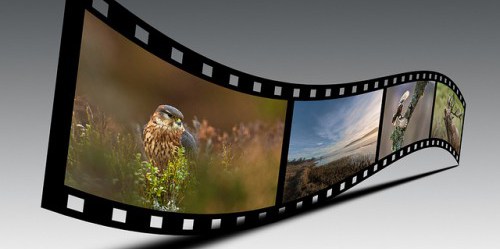
BOGOR, Indonesia (5 September, 2013)_Wildlife documentaries are big business. The BBC’s Planet Earth television series leads the pack – it cost $12 million to make, generated $34 million in the first year of its release and reached a record breaking 100 million people in over 100 countries.
Wildlife films are also a powerful tool in raising awareness of conservation and environmental issues. But the entertainment value we get from seeing leopards, tigers and sharks on our screens doesn’t directly translate into real value conservation activities, most of which are grossly underfunded.
So with their large profits and universal impact, do filmmakers have a responsibility to help protect the species they film? Should they pay for the biodiversity they rely on?
A paper published in Science in 2011 suggests a new form of conservation finance, where the revenues generated from the screening of wildlife programmes and sale of DVDs could be used for financing biodiversity conservation.
Filmmakers would no longer ‘free-ride on nature’, the authors argue, but would allegedly be subjected to a payments for environmental services (PES) scheme that actively contributes to the protection of the biodiversity they film. It is a novel solution, and one that raises an interesting debate on the boundaries of PES, but what are the obstacles and long term-implications?
It is an interesting and provocative idea, but in a recent paper published in the journal Oryx, we argue that there are arguably a number of flaws with this proposal, starting with the mislabelling of the mechanism as “PES”. According to Jepson et al. in their rebuttal, ‘the goal [of certification] is to widen and increase financial flows for the protection and restoration of ecosystems’. This is different from all current conceptual definitions of PES, as a tool that ‘aims to create incentives to align individual and/or collective land use decisions with the social interest in the management of natural resources’.
To clarify, PES is a voluntary mechanism that depends on the relationship between service users (here, the broadcasters) and service providers. If the agreed rules are violated, payments would be reduced or stopped. It is the direct link between payments charged and incentives disbursed that is at the very heart of PES.
The proposed PES trust fund does not specify a direct recipient of the money, therefore not providing any incentive to bring about behavioural change in resource management. For this trust fund to work as a PES mechanism, filmmakers should only make payments on the condition that environmental services were safeguarded or improved. The unanswered question then is what factors determine adequate “service provision” on the ground, and who thus might need to receive an incentive to improve their performance.
The evidence is strong enough to suggest that we should be supporting, maybe even subsidizing, the production of nature documentaries rather than making it harder and more expensive.
Even as a pure financing mechanism, the large transaction costs needed to set up a certification body could devour the lion’s share of the funds available, and thus benefit the middle men more than conservation. There’s also the problem of enforceability – who would be held accountable for payments not made? Who would manage this fund, and how would the funds be administered?
So if this is not PES, then what type of mechanism are we talking about? We’ve argued before that a compulsory certification payment would constitute a tax or levy on nature films; however in a voluntary certification mechanism, as pointed out by Jepson and Jennings, a “fee” would be more appropriate.
Whatever the label, the impact could end up being detrimental: by raising the cost of production for broadcasters, the cost will inevitably fall to consumers through an increase in DVD prices or pay-per-view subscription channels, resulting in a curtail in demand and fewer nature programs.
Wildlife documentaries have played an instrumental role in raising awareness of environmental issues, pushing the conservation agenda, and driving donations to environmental NGOs. While Jepson and Jennings argue that the advocacy content of a new breed of conservation programmes is dwindling, we believe they are still an important educational tool, strengthening people’s knowledge and relationship with nature, particularly for children and people in urbanized areas, who are often disconnected from their surrounding natural environment.
While more research needs to be done to better understand how viewers interact with nature programs, the evidence is strong enough to suggest that we should be supporting, maybe even subsidizing, the production of nature documentaries rather than making it harder and more expensive.
Rather than short-sighted financial schemes to raise new funds, emphasis needs to be on how to spend limited conservation resources sensibly. A drive for extra conservation cash in the short term could undermine not only the long term financing of conservation activities, but people’s long term love of nature.
If a discussion needs to be had on the boundaries of PES and whether professional people should pay for the environment they use, then where does the buck stop? Should we, as scientists, pay to have this debate and write this blog?
Sven Wunder is a senior economist with CIFOR and Douglas Sheil is currently a visiting professor at Southern Cross University, NSW, Australia, director of the Institute of Tropical Forest Conservation (ITFC) and a CIFOR senior associate. For more information, contact them at s.wunder@cgiar.org and Douglas.Sheil@scu.edu.au
To find out more about CIFOR’s research on Payments for Environmental Services (PES), which is supported by the CGIAR Research Program on Forests, Trees and Agroforestry, visit //www.cifor.org/pes
We want you to share Forests News content, which is licensed under Creative Commons Attribution-NonCommercial-ShareAlike 4.0 International (CC BY-NC-SA 4.0). This means you are free to redistribute our material for non-commercial purposes. All we ask is that you give Forests News appropriate credit and link to the original Forests News content, indicate if changes were made, and distribute your contributions under the same Creative Commons license. You must notify Forests News if you repost, reprint or reuse our materials by contacting forestsnews@cifor-icraf.org.